A new technique developed by Ben- Gurion University researchers in Israel has generated mouse sperm cells from testicular germ cells in a petri dish. While it will take time to jump to human experimentation, Prof. Mahmoud Huleihel and his research group call their in vitro work a “breakthrough” that could eventually help infertile men who cannot produce sperm, as well as boys before puberty who are at risk of infertility after undergoing aggressive therapies and, at a young age, cannot produce sperm for freezing for later use.
Germ cells give rise to the gametes, which are cells that fuse with other cells in an organism that reproduces sexually.
Huleihel, who is part of the Shraga Segal Department of Microbiology and Immunology in the Faculty of Health Sciences in Beersheba, published an article on the achievement in the Asian Journal of Andrology.
- Israeli Hospital Becomes World-Famous Center For Fertilization Procedures
- Sperm Quality Goes Up During Cooler Months, Increases Fertility
- Male Birth-Control: Taking The Pill No Longer Just For Women
Huleihel and his team, which pioneered the technique, used a threedimensional culture system (SACS) on a bed of agar (processed seaweed) to generate the sperm.
The study was performed in cooperation with Prof. Eitan Lunenfeld at Soroka University Medical Center and Prof. Stefan Schlatt of the University of Münster in Germany.
The researchers said SACS has the capacity to induce testicular germ cells to reach the final stages of spermatogenesis and have a normal shape. The mice who were experimented on were only seven days old.
Huleihel said that most attempts to culture male germ cells have used twodimensionalcell culture systems. But their unique three-dimensional cell culture system using soft agar “is more representative” of natural conditions to which a cell is exposed in an organ. In the past, the three-dimensional SACS has been used to investigate proliferation and differentiation of bone marrow and blood cells in vitro.
Related posts

Israeli Medical Technologies That Could Change The World

Harnessing Our Own Bodies For Side Effect-Free Weight Loss

Missing Protein Could Unlock Treatment For Aggressive Lung Cancer





Facebook comments